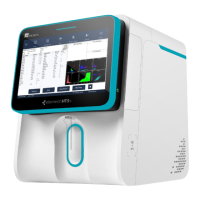Vers.: 20230710ENG
Page 21
First, the RBC are lysed and the WBC subpopulations are made different in size and
complexity by the lyse. The nucleic acid substances in WBC are marked by the new
asymmetric cyanine fluorescent substance. Due to the different content of nucleic acid in
different WBC subpopulations, maturity stages or abnormal development status, the volume
of fluorescent dye staining the nucleic acid substances is different. Surrounded with sheath
fluid (diluent), the blood cells pass through the center of the flow cell in a single column at a
faster speed. When the blood cells suspended in the diluent pass through the flow cell, they
are exposed to a laser beam: the front scatter reflects the cell size, the side scatter reflects the
intracellular granularity, and the intensity of the fluorescent signal reflects the degree the cell
is stained. By sensing the difference in signal in three dimensions of the cells processed with
lyse, the WBC channel differentiates the subpopulations of WBC (lymphocytes, monocytes,
neutrophil, eosinophils and basophils), and provides flags for suspected band cells, atypical
lymphocytes, immature granulocytes and nucleated red blood cells.
3.3 HGB measurement
3.3.1 Colorimetric method
A part of the sample is delivered to the HGB bath where it is bubble mixed with a certain
amount of lyse, which converts hemoglobin to a hemoglobin complex that is measurable at
530 nm. A LED is mounted on one side of the bath and emits a beam of monochromatic light,
whose central wavelength is 530 nm. The light passes through the sample and is then
measured by an optical sensor that is mounted on the opposite side. The signal is then
amplified, and the voltage is measured and compared to the blank reference reading (readings
taken when there is only diluent in the bath), and the HGB is measured and calculated in the
analyzer automatically.
3.3.2 HGB
The HGB is calculated per the following equation and expressed in g/dL.
HGB (g/dL) = Constant × Log 10 (Blank Photocurrent/Sample Photocurrent).
3.4 RBC, PLT and RET measurement
3.4.1 RBC and PLT: Sheath flow impedance method
RBC/PLT are counted and sized by the sheath flow impedance method. This method is based
on the measurement of changes in electrical resistance produced by a particle, which in this
case is a blood cell, suspended in a conductive diluent as it passes through an aperture of
known dimensions. A pair of electrodes are submerged in the liquid on both sides of the
aperture to create an electrical pathway. As each particle passes through the aperture, a
transitory change in the resistance between the electrodes is produced. This change produces
a measurable electrical pulse. The number of pulses generated represents the number of
particles that passed through the aperture. The amplitude of each pulse is proportional to the
volume of each particle.

